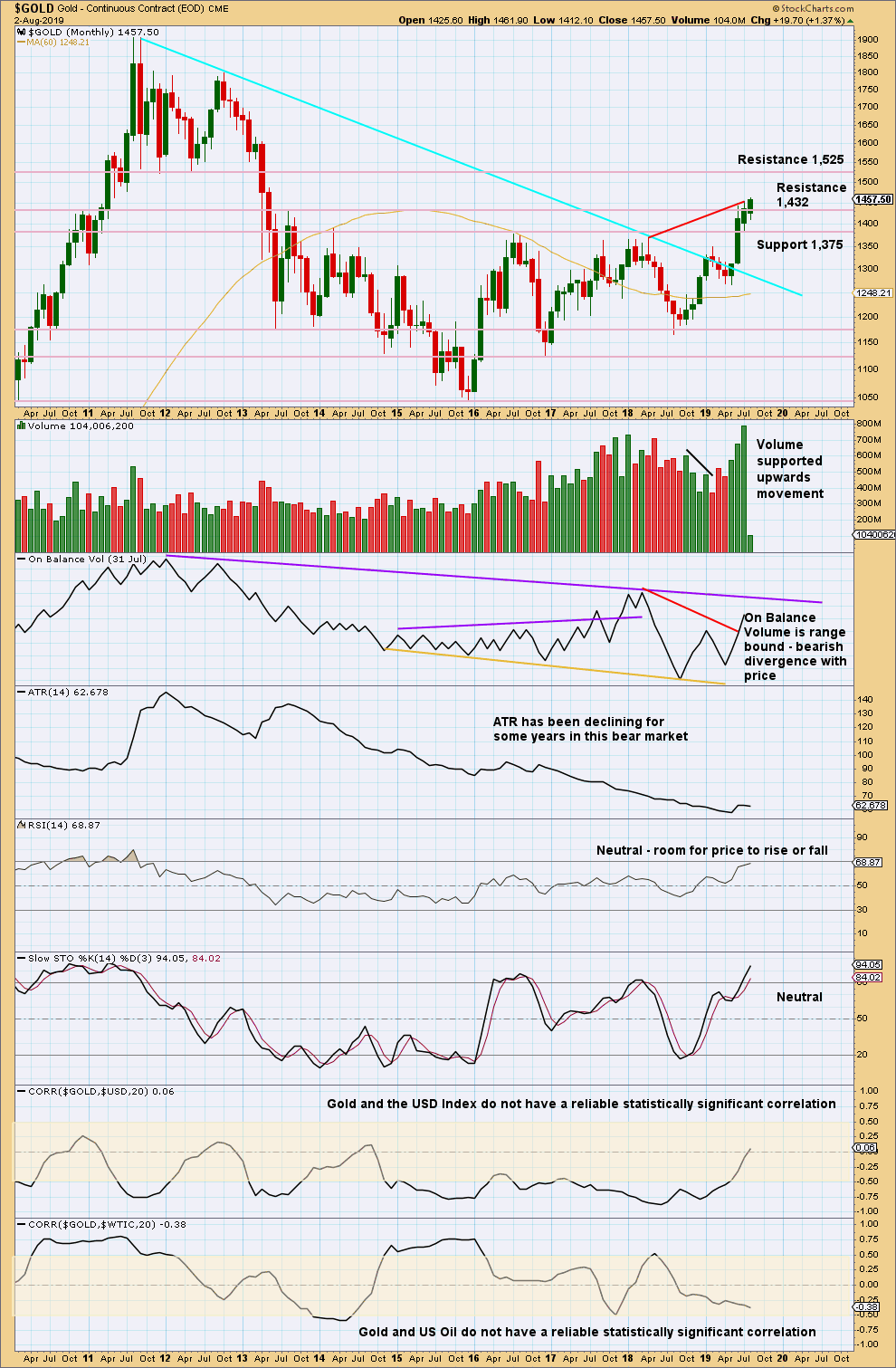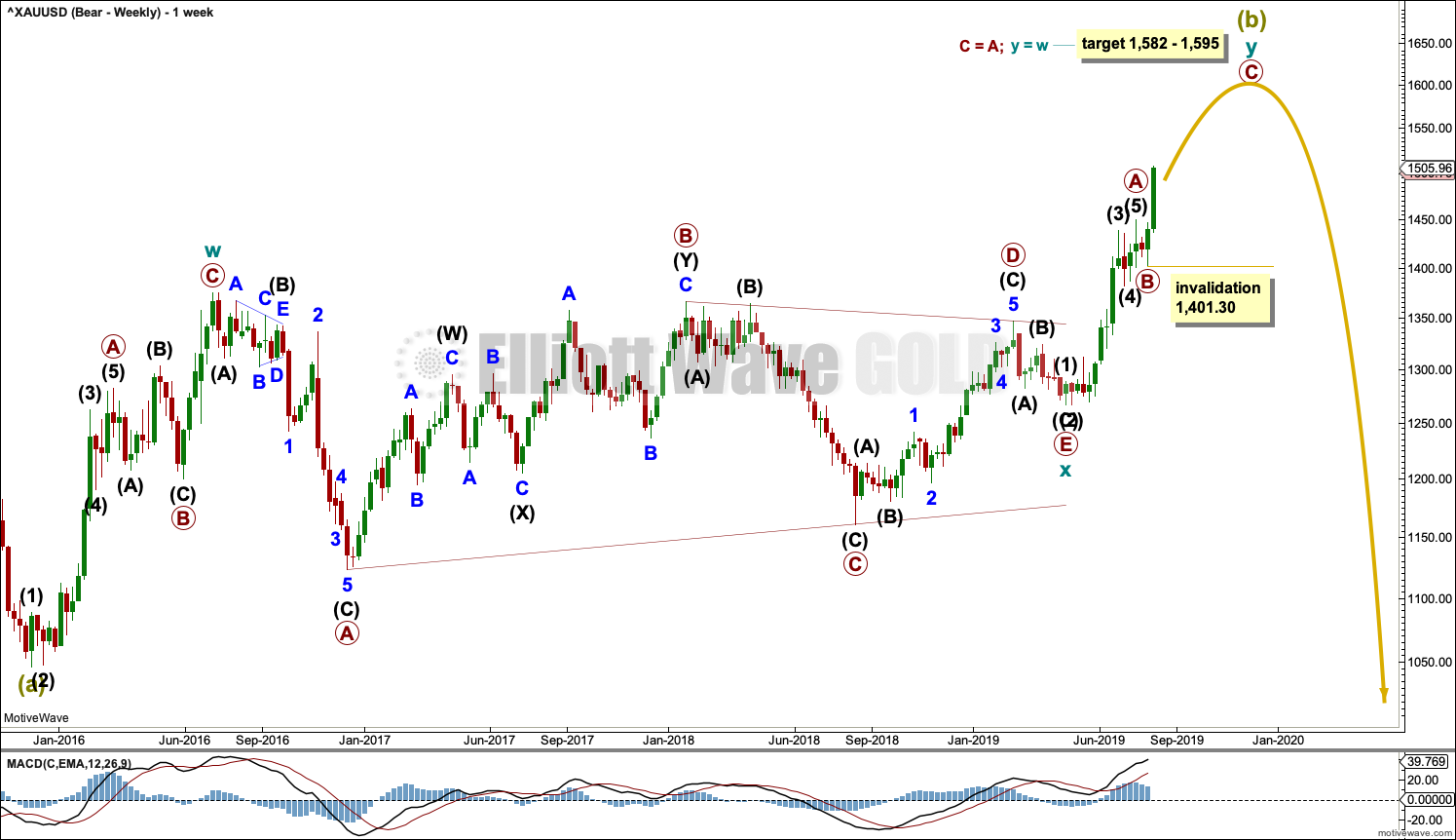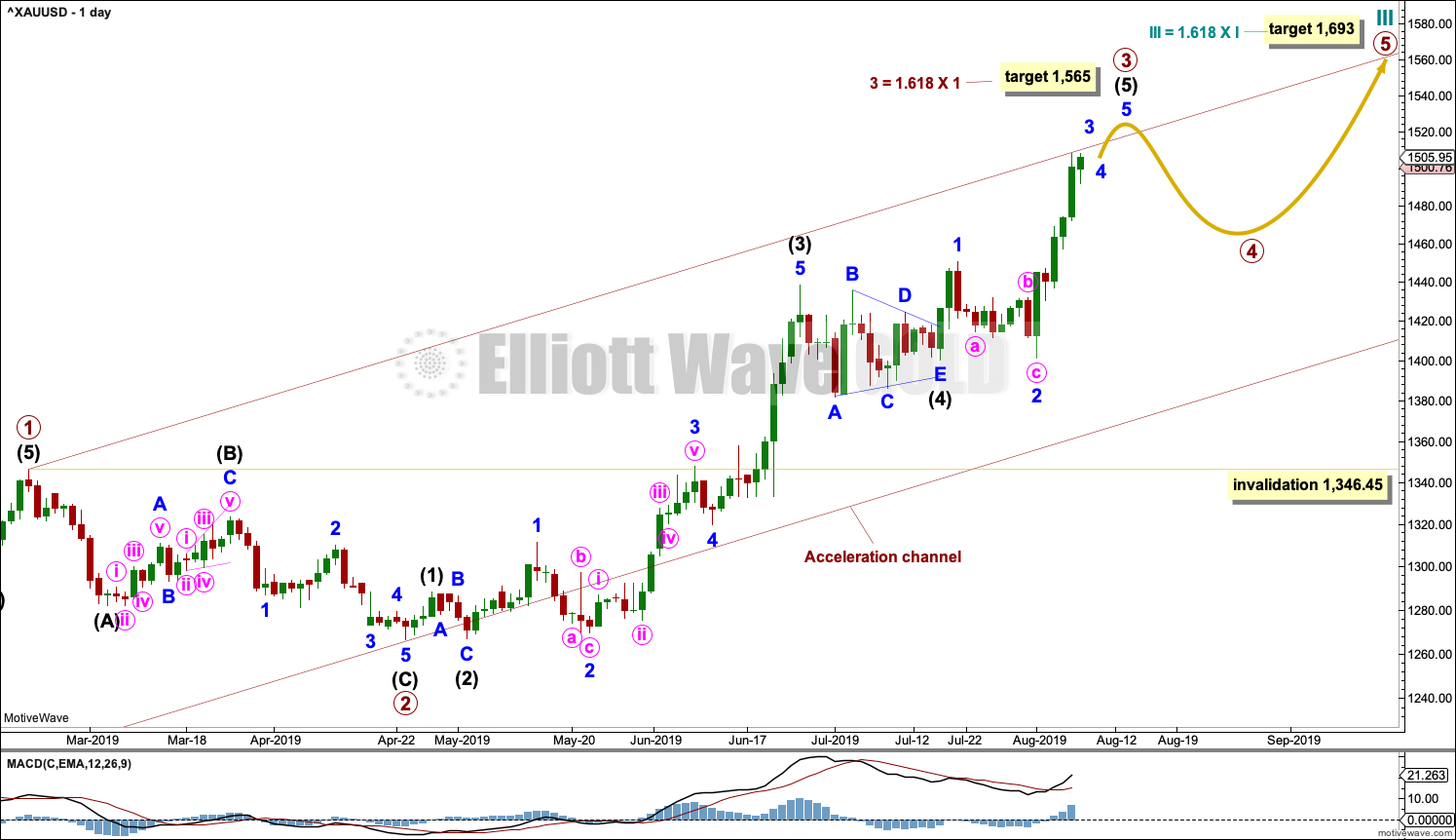Both Elliott wave counts have targets which expect more upwards movement. A small range inside day does not change the expectation.
Summary: There is an upwards trend in place that is very extreme. Conditions are overbought. This can continue while price moves a considerable distance further, or a trend change may occur at any time now. Caution is warranted. Risk management is essential.
The bullish Elliott wave count expects a large interruption to the trend to begin about 1,565.
The bearish Elliott wave count expects the upwards trend to end about 1,582 to 1,595.
Grand SuperCycle analysis is here.
Monthly charts were last published here with video here.
BEARISH ELLIOTT WAVE COUNT
WEEKLY CHART
This is now the sole remaining bearish Elliott wave count.
It remains possible that Super Cycle wave (b) is an incomplete double zigzag.
The first zigzag in the double is labelled cycle wave w. The double is joined now by a three in the opposite direction, a triangle labelled cycle wave x. The second zigzag in the double is labelled cycle wave y.
Cycle wave y must subdivide as a zigzag if Super Cycle wave (b) is a double zigzag. Within cycle wave y, primary waves A and B may now be complete. No second wave correction within primary wave B may move beyond its start below 1,401.30.
DAILY CHART
Primary wave C must complete as a five wave structure. So far intermediate waves (1) and (2) may be complete. Intermediate wave (4) may not move into intermediate wave (1) price territory below 1,446.51 (this price point is taken from the hourly chart).
The target is widened to a zone. When intermediate waves (3) and (4) may be complete, then the target calculation may be added to at intermediate degree. At that stage, it may be narrowed or change.
HOURLY CHART
Primary wave C must complete as a five wave structure, most likely an impulse, which is what it looks to be unfolding as.
A best fit channel is drawn about primary wave C. This channel is slightly adjusted today. When the channel is strongly breached by downwards movement, then primary wave C may be complete.
BULLISH ELLIOTT WAVE COUNT
WEEKLY CHART
This wave count sees the the bear market complete at the last major low for Gold in November 2015.
If Gold is in a new bull market, then it should begin with a five wave structure upwards on the weekly chart. However, the biggest problem with this wave count is the structure labelled cycle wave I because this wave count must see it as a five wave structure, but it looks more like a three wave structure.
Commodities often exhibit swift strong fifth waves that force the fourth wave corrections coming just prior and just after to be more brief and shallow than their counterpart second waves. It is unusual for a commodity to exhibit a quick second wave and a more time consuming fourth wave, and this is how cycle wave I is labelled. This wave count still suffers from this very substantial problem, and for this reason the bearish wave count is still considered because it has a better fit in terms of Elliott wave structure.
Cycle wave II subdivides well as a double combination: zigzag – X – expanded flat.
Cycle wave III may have begun. Within cycle wave III, primary waves 1 and 2 may now be complete. Primary wave 3 has now moved above the end of primary wave 1 meeting a core Elliott wave rule. It has now moved far enough to allow room for primary wave 4 to unfold and remain above primary wave 1 price territory. Primary wave 4 may not move into primary wave 1 price territory below 1,346.45.
Cycle wave III so far for this wave count would have been underway now for 51 weeks. It may be beginning to exhibit some support from volume and increasing ATR. This wave count now has some support from classic technical analysis.
Redraw an acceleration channel about primary waves 1 and 2: draw the first trend line from the end of primary wave 1 to the last high, then place a parallel copy on the low of primary wave 2. Keep redrawing the channel as price continues higher. When primary wave 3 is complete, then this channel would be drawn using Elliott’s first technique about the impulse. The lower edge may provide support.
DAILY CHART
Primary wave 3 may only subdivide as an impulse. Within the impulse, intermediate waves (1) through to (4) are all now complete. The structure of intermediate wave (5) is now incomplete, so it needs to move higher.
When it arrives, then primary wave 4 may not move into primary wave 1 price territory below 1,346.45.
Because intermediate wave (5) is a fifth wave to end a third wave one degree higher, at primary degree, it may exhibit swift strong movement. It may end with a blow off top.
HOURLY CHART
Intermediate wave (5) may only subdivide as a five wave structure, either an impulse or an ending diagonal. Fifth waves to end third waves one degree higher, as this one is, almost always subdivide as impulses (that is what shall be expected).
Within intermediate wave (5), minor waves 1 and 2 may now both be complete.
Minor wave 3 may only subdivide as an impulse. Within minor wave 3, minute waves i to iv may now be complete.
Minute wave iv may not move into minute wave i price territory below 1,446.51.
Look out for the possibility of one or both of minute wave v to end minor wave 3 or minor wave 5 to end primary wave 3 to be blow off tops.
The best fit channel is drawn the same way on both hourly charts today. Expect the lower edge to provide support for pullbacks along the way up. If the lower edge is breached, then the upwards trend may be either over or a larger pullback or consolidation to last a few days or so may have begun.
TECHNICAL ANALYSIS
MONTHLY CHART

Click chart to enlarge. Chart courtesy of StockCharts.com.
Gold has effected an upwards breakout above multi-year resistance and above the cyan bear market trend line. Look for next resistance identified on the chart.
The new high in price above prior highs for March / April 2018 have not been matched by new highs for On Balance Volume. This divergence is bearish and supports a bearish Elliott wave count. This divergence may be given a little weight because it is strong and evident on the monthly chart.
WEEKLY CHART

Click chart to enlarge. Chart courtesy of StockCharts.com.
The bottom line remains that a multi year breakout occurred a few weeks ago, and it occurred with strength in volume. ADX is now extreme and conditions are overbought. Some consolidation or pullback may reasonably be expected here to relieve extreme conditions.
The last weekly candlestick closes strong with support from volume. This is not however matched by strength on the daily chart.
DAILY CHART

Click chart to enlarge. Chart courtesy of StockCharts.com.
Look for support in the first instance at last resistance, which is now at 1,455. Today’s inside day looks like a small pause within an ongoing trend. There is as yet no evidence of a reversal.
There is resistance about here at 1,520. Next reasonable resistance above is about 1,600.
Assume the upwards trend remains in place until proven otherwise. Proven otherwise may be a strong bearish candlestick pattern, particularly if it comes after a blow off top.
GDX WEEKLY CHART

Click chart to enlarge. Chart courtesy of StockCharts.com.
Last week completes a lower low and lower high, but the candlestick has closed green and the balance of volume was upwards. Upwards movement within the week may have support from volume, but daily volume bars would better be analysed to draw a conclusion here.
The upwards trend is not yet extreme. A long lower wick on this weekly candlestick is bullish.
GDX DAILY CHART

Click chart to enlarge. Chart courtesy of StockCharts.com.
The last gap is now closed. It is renamed an exhaustion gap. It is now more possible that there is a high in place, at least temporarily. There is no bearish candlestick reversal pattern.
Published @ 07:41 p.m. EST.
—
Careful risk management protects your trading account(s).
Follow my two Golden Rules:
1. Always trade with stops.
2. Risk only 1-5% of equity on any one trade.
—
New updates to this analysis are in bold.







Bearish count hourly chart updated:
Has the bullish wavexount changed. Large addition of short positions added today
No, it hasn’t.
At what price point bearish count gets invalidated on the back of continuing uptrend?
You are correct to warn of overbought condition/risk.
It is called wall of worry??
There are many cases where extreme overbought condition continued for many years.
Please do not consider comment as critical just providing information.
Below is a chart of Japan index NIKK index bubble from 1983 to 2010.
I don’t think looking at the Nikkei is a good indication of what Gold can do.
I’m looking at the last strong bullish move for Gold from October 2008 to September 2011.
ADX can reach very extreme and continue for a couple of weeks. It reached almost up to 60 on 20th November 2009.
Looking at the most extreme overbought portion of that rise, up to 3rd December 2009, to answer your question:
Once both ADX was very extreme (above 45 and above both directional lines) and RSI reached overbought on the 12th November 2009, price continued higher until a high on 3rd December 2009. Price moved $120.90 and the trend continued for 14 sessions.
After the high on 3rd December 2009 there was a big correction down until 14th February 2010.